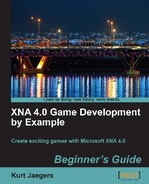With the release of Windows 95, Microsoft also introduced the DirectX Application Programming Interface (API), which allowed Windows-based applications to integrate closely, in a standard way, with the graphics hardware available on the system. Prior to DirectX, most PC game development targeted MS-DOS, as Windows-based graphics were too slow for most gaming needs.
Although faster, working with the DirectX API could be challenging. The DirectX Software Development Kit (SDK) is targeted at C++, with no official support for other languages. The developer is also faced with large volumes of background work to get a DirectX project to the point where he can display images on the screen before ever considering the logic of the game itself.
In 2002, Microsoft released Managed DirectX as an interface to the API from its new .NET development environment. The .NET Framework consists of a set of code libraries to perform common programming tasks, and the Common Language Runtime (CLR) which allows code written in the various .NET languages (including Visual Basic .NET and C#) to be compiled into common runtime code. In order to support devices such as Windows Mobile phones, a subset of the .NET Framework was released, called the .NET Compact Framework. The .NET CF, as it is often abbreviated, removed non-essential components of the full Framework in the interest of saving storage space on handheld devices.
While Managed DirectX 2.0 was still in the beta phase, the project was cancelled, and Microsoft XNA was introduced in its place. XNA consists of the XNA Framework, a set of code libraries to perform common graphics, sound, and other game related tasks, and XNA Game Studio, an extension of the Visual Studio C# interface that includes a number of project templates to make use of the XNA Framework.
The XNA project templates include an integrated game loop, easy to use (and fast) methods to display graphics, full support for 3D models, and simple access to multiple types of input devices.
In addition to Windows games, XNA allows deployment to both the Xbox 360, the Zune handheld media player (with XNA 3.1) and Windows Phone 7 Series phones (with XNA 4.0). For the first time, a game console manufacturer has released a supported method for individual game developers to create (and sell!) content for their game console. Microsoft has even established the Xbox Indie Games system on Xbox Live to allow you to sell your creations to the world.
Tip
What does XNA stand for, anyway?
According to the developers, XNA is an acronym for "XNA's Not Acronymed".
In this introductory chapter you will:
- Look at an overview of the games presented in this book
- Download and install XNA Game Studio
- Create a new Windows Game project
- Modify the default Windows Game template to build your first XNA game
Many beginning developers make the mistake of attempting to tackle far too large a project early on. Modern blockbuster video games are the result of the efforts of hundreds of programmers, designers, graphic artists, sound effects technicians, producers, directors, actors, and many other vocations, often working for years to create the game.
That does not mean that the efforts of a solo developer or small team need to be dull, boring, and unplayable. This book is designed to help you develop a solid understanding of 2D game development with XNA Game Studio. By the time you have completed the projects in this book, you will have the knowledge necessary to create games that you can complete without an army of fellow game developers at your back.
In this chapter, you will build your first XNA mini game, chasing squares around the screen with your mouse cursor. In subsequent chapters the following four more detailed games are presented:
Flood Control: An explosion in one of the research laboratories has cracked the pressure dome protecting your underwater habitat. Work quickly to construct a series of pipes to pump water out of the habitat before it floods. Flood Control is a board-based puzzle game with simple game mechanics and slowly increasing difficulty.
Asteroid Belt Assault: After being separated from your attack fleet in Hyper Space, you find yourself lost in an asteroid field without communications or navigation systems. Work your way through the chaos of the asteroid belt while combating alien pilots intent upon your destruction. A vertically scrolling space shooter, Asteroid Belt Assault introduces scrolling backgrounds, along with player and computer controlled characters.
Robot Rampage: In the secret depths of a government defence facility, a rogue computer has taken control of robotic factories across the world, constructing an army of mechanical soldiers. Your mission infiltrate these factories and shut down their network links to break the computer's control. A multi-axis shooter utilizing both of the analog control sticks on the Xbox 360 gamepad controller, Robot Rampage generates and manages dozens of on-screen sprites and introduces world map construction.
Gemstone Hunter: Explore the Australian wilderness, abandoned mines and ancient caves in a search for fabulous treasures. In Gemstone Hunter you will construct a classic platform-style game, including a Windows Forms-based level editor and a multi-map "world" to challenge the player.
The games are each presented over two chapters. In the first chapter, the basics are implemented to the point where the game is playable. In the second chapter, features and polish are added to the game.
Each game introduces new concepts and expands on topics covered in the previous games. At the end of each game chapter, you will find a list of exercises challenging you to use your newly gained knowledge to enhance previous games in the book.
We will focus on Windows as our platform for the games presented in this book. That said, the code presented in this book requires very little in the way of changes for other XNA platforms, generally only requiring implementation of platform-specific controls (gamepads, touch screen, and so on) and consideration of the differences in display sizes and orientation on non-Windows devices.
